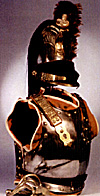
The wars of this period were fought with armies composed of soldiers and weapons very similar to the conflicts of the previous fifty years. The main differences were the organization of enormous armies and the development of mass tactics. There were three main branches of a nation's land military force:
Infantry
The backbone of an army on the battlefield was the infantry of the line -- the battle line. The building block was the battalion, with a full strength of 600-1,200 men, subdivided into four to ten companies.
To move such bodies of men required discipline and drill, and upon that drill was built an elaborate but crucial repertoire of evolutions designed to change formations and bring the battalion to battle in good order and with confidence. Usually armed with a muzzle-loading smoothbore musket which fired a 1-ounce lead ball, soldiers were deployed in a line of three closely packed ranks (although Britain and some others made use of two ranks), a formation which maneuvered slowly and fired in volleys of 1-2 rounds per minute.
More rapid movement was accomplished in a variety of columns -- a potentially misleading term as most columns had more men ranked across their front than were in files from back to front. To defend against cavalry attack, infantry often sought to deter the horses with a hedge of bayonets and to deny the enemy a vulnerable flank or rear by forming one of a variety of squares.
While usually capable of line duty, "light" infantry, whether whole battalions or in companies, provided skirmishers. Often, but not always, regarded as a minor elite, such troops spread out in loose or open order to harass the enemy with individual aimed fire, to probe and scout, and to prevent the enemy from doing likewise. Grenadiers were seen as an elite body. Either as a company within a battalion, or companies grouped into provisional grenadier battalions, these troops were frequently used for special or arduous assignments.
Cavalry
Cavalry reached perhaps its most glorious chapter in history during the Napoleonic Wars. Improving firepower would eventually make mounted soldiers too vulnerable, but this era saw the last great cavalry charges that broke up whole units of infantry and scattered a defeated foe by aggressive pursuit.
Mounted troops boasted far greater maneuverability and shock power than their foot-bound counterparts. Cavalry was simultaneously the most fragile of the three arms -- horses required more regular feeding and care than men, and their strength had to be husbanded for optimum moments of action.
Cavalry operated in squadrons of 90-250 troopers, and those squadrons (ranging from 2 to 10) usually functioned together in a regiment. Possibly even more dependent on discipline and drill than infantry, not least owing to the challenges of controlling the horses individually and as a group, greater training was required for cavalry. Relying almost exclusively on the shockpower of the charge (rather than firepower), it was critical that a cavalry unit charged with control and rally quickly after combat; arguably a certain extra elan was required of its leaders. Cavalry normally deployed in two ranks (although the use of three lingered in Russia and Austria for a time). It employed a variety of line and column formations as well, often positioning the squadrons of the regiment so as to provide support for other squadrons of the regiment.
Cavalry was divided into "light" and "heavy" categories. The former employed smaller men on lighter, faster horses for the purposes of skirmishing and scouting (although it was capable of battlefield action), and included light dragoons, lancers, and hussars. The heavies usually had bigger men mounted on larger horses as the army's battle cavalry. It operated in large, close order combinations, and included dragoons and specially armored cuirassiers.
Artillery
Napoleon's training was in the artillery and he raised it to a new level of importance. The weapons it used in the field (as distinct from siege, fortress, or naval ordnance) defined artillery: guns and howitzers. Normally a battery or company of 4-6 guns were combined with 1-2 howitzers and 90-180 gunners (heavier guns required larger crews).
To move cannon required limbers drawn by 4-6 horses, supported by ammunition wagons, caissons, mobile forges, a spare wheel cart, baggage, and other vehicles. At the opening of the period, many nations employed civilian contractors as drivers, although by the end of the Revolutionary period virtually every nation had "militarized" its artillery trains.
The main distinction between field artillery categories was that of "foot" and "horse" artillery. In the former, which comprised the majority of artillery units, the gunners accompanied their pieces on foot; the latter had the gunners all mounted, which permitted more rapid movement and bequeathed a certain eliteness to this category.
Napoleon massed his guns together in "grand batteries" and kept a substantial reserve. Only the Russians matched the French in numbers of guns deployed with an army. Serving a gun was exhausting work, as the 1,300-3,500-lb. piece recoiled as much as 15 feet with each shot and had to be physically "run up" back into position and resited.
Artillery had a powerful impact on the battlefield, but it was vulnerable, particularly to flanking attacks, if left unsupported.
Back to Table of Contents -- Napoleon #17
Back to Napoleon List of Issues
Back to MagWeb Master Magazine List
© Copyright 2001 by Napoleon LLC.
This article appears in MagWeb (Magazine Web) on the Internet World Wide Web.
The full text and graphics from other military history magazines and gaming magazines are available at http://www.magweb.com
Order Napoleon magazine direct